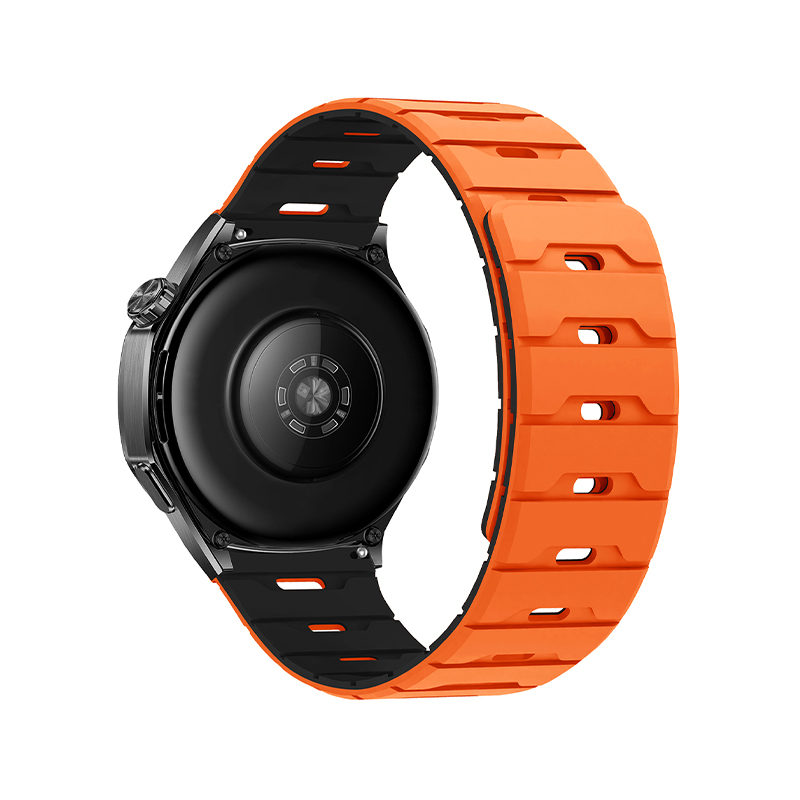How is the magnetic module design of the silicone magnetic watch strap designed to prevent it from falling off?
Release Time : 2025-11-04
The anti-slip design of the magnetic module in a silicone magnetic watch strap requires comprehensive consideration from multiple dimensions, including optimized magnetic structure, auxiliary fixing mechanisms, material compatibility, and adaptability to dynamic scenarios. Its core lies in enhancing the stability and reliability of the magnetic force through technological means, while also ensuring wearing comfort and ease of use.
The anti-slip design of the magnetic module primarily relies on the precise design of the magnetic force distribution. Traditional single-point magnetic attraction is prone to strap misalignment due to uneven force distribution, while a multi-point array magnetic layout distributes the magnetic force points, resulting in more even force distribution on the attraction surface. For example, symmetrically distributed magnetic pole pairs are placed at the connection end of the silicone magnetic watch strap, with each pair generating directional magnetic lines of force, forming a closed magnetic circuit. This design not only improves the initial attraction force but also reduces the risk of slippage when the strap is subjected to lateral tension by redistributing stress through the magnetic lines of force. Furthermore, the polarity arrangement of the magnetic poles must avoid like poles repelling each other; typically, opposite poles are used to ensure that the silicone magnetic watch strap can quickly align and securely attach at any angle.
The auxiliary fixing mechanism is a crucial supplement to the anti-slip design. Simply relying on magnetic attraction may be insufficient under vigorous movement or external impact, thus requiring the introduction of a mechanical locking structure. For example, a spring-loaded buckle can be placed around the magnetic module. When the strap is in place, the buckle automatically springs into a groove on the strap or dial, forming a double fixation. This buckle is usually made of silicone, ensuring both elasticity and preventing scratches. Another design involves adding an adjustable locking ring to the end of the strap. After wearing the watch, the user passes the locking ring through a fixing hole on the strap and tightens it, physically preventing the strap from accidentally loosening. The locking ring's material must match the main body of the strap to ensure overall softness and comfort.
Material compatibility directly affects the long-term stability of the magnetic module. The silicone magnetic watch strap must be made of highly elastic, aging-resistant silicone to withstand frequent bending and stretching. The magnets in the magnetic module must have high remanence and low coercivity to ensure minimal magnetic attenuation after long-term use. Simultaneously, the bonding process between the magnet and the silicone is crucial. High-strength adhesive or embedded injection molding is typically used to completely encapsulate the magnet in the silicone, preventing it from detaching due to impact or friction. In addition, the silicone coating on the watch strap surface must have anti-slip properties. A micro-textured design increases friction with the skin, further reducing the possibility of the strap slipping off.
Dynamic scene adaptability requires the anti-slip design to cope with different usage environments. For example, in sports scenarios, the silicone magnetic watch strap needs to withstand large swings and sweat. In this case, a waterproof design for the magnetic module is essential. A sealing ring around the magnet prevents sweat from seeping in, causing the magnet to rust or the adhesive to fail. In low-temperature environments, silicone may harden and lose elasticity; therefore, a cold-resistant silicone material must be selected to ensure that it maintains its softness and adhesion at low temperatures. Furthermore, the anti-interference capability of the magnetic module must also be considered to prevent the magnetic force from weakening when near strong magnetic fields.
User ease of use is an indispensable aspect of the anti-slip design. The magnetic module's attachment and detachment must be "one-click to attach, one-click to detach," avoiding user abandonment due to complicated operation. For example, by optimizing the shape of the magnetic poles and the guide bevel design at the strap connection end, users can quickly align the magnetic position when wearing the watch, reducing the hassle of repeated adjustments. Meanwhile, the unlocking method of the auxiliary fixing mechanism needs to be simple and intuitive. For example, an elastic buckle can be easily released by pressing or sliding, avoiding difficulties in unlocking that could negatively impact the user experience.
From a long-term usage perspective, the durability of the anti-slip design is equally crucial. The magnetic module needs to pass fatigue testing, simulating scenarios of frequent wearing and removal by the user, to ensure that the adhesion strength between the magnet and the silicone remains up to standard after thousands of uses. Furthermore, the overall tear resistance of the strap also needs to be considered; by adding fiber reinforcement materials to the silicone, the strap's resistance to breakage under tensile stress can be improved.







